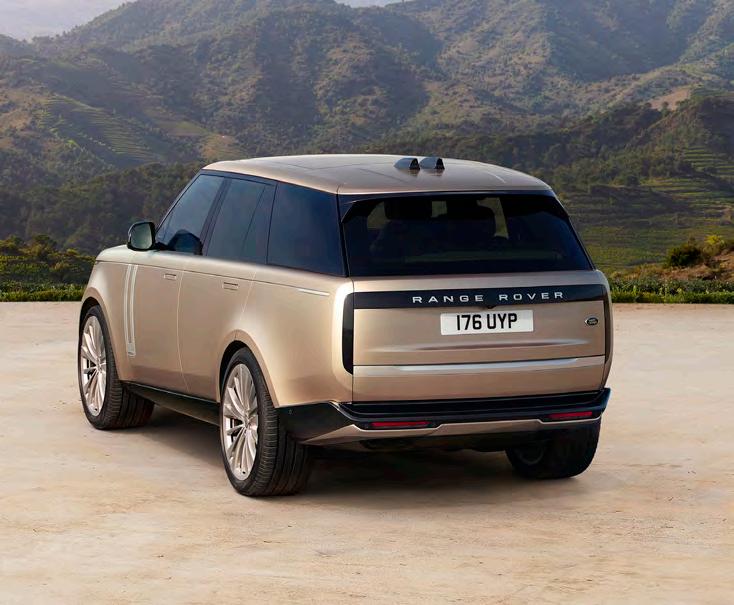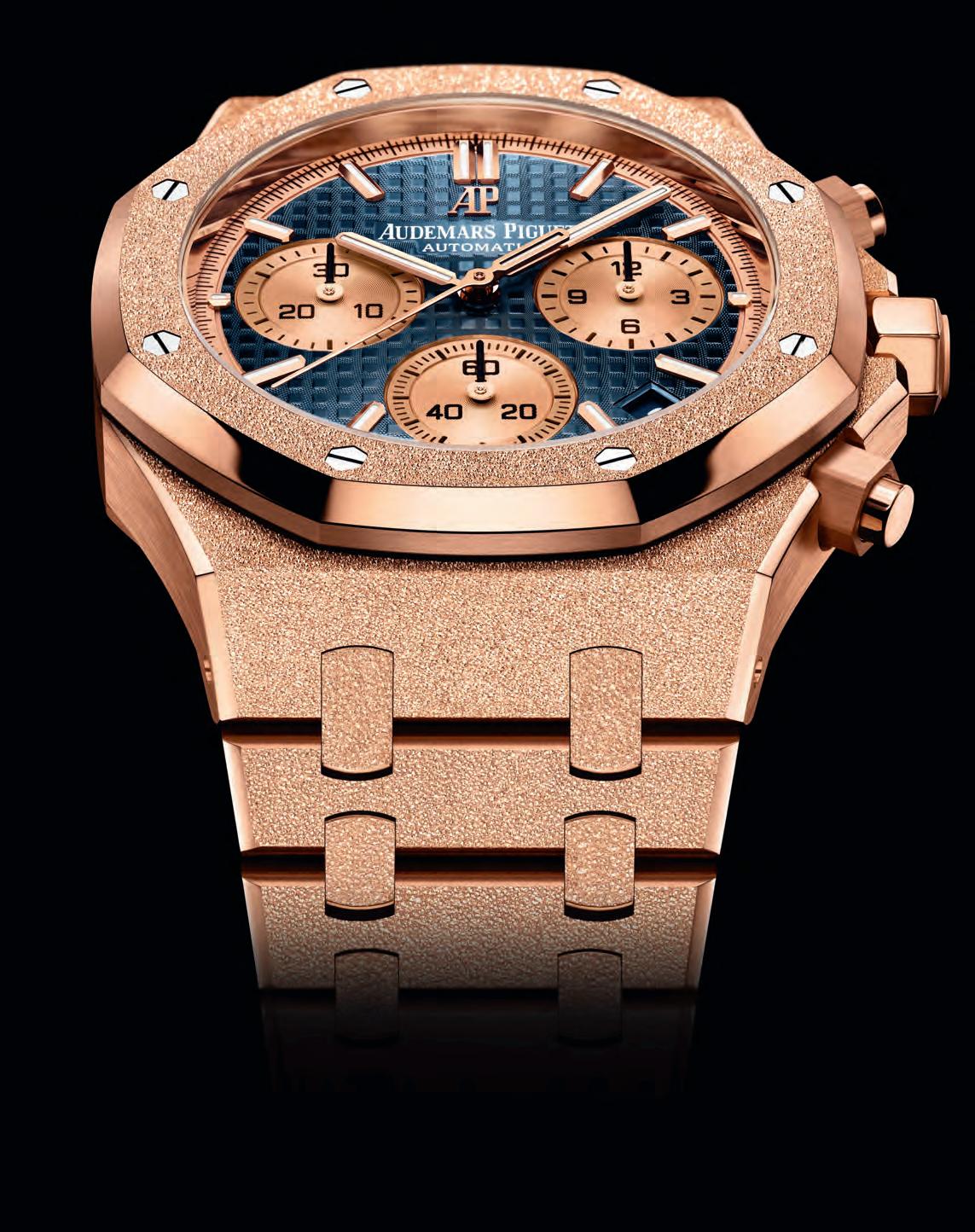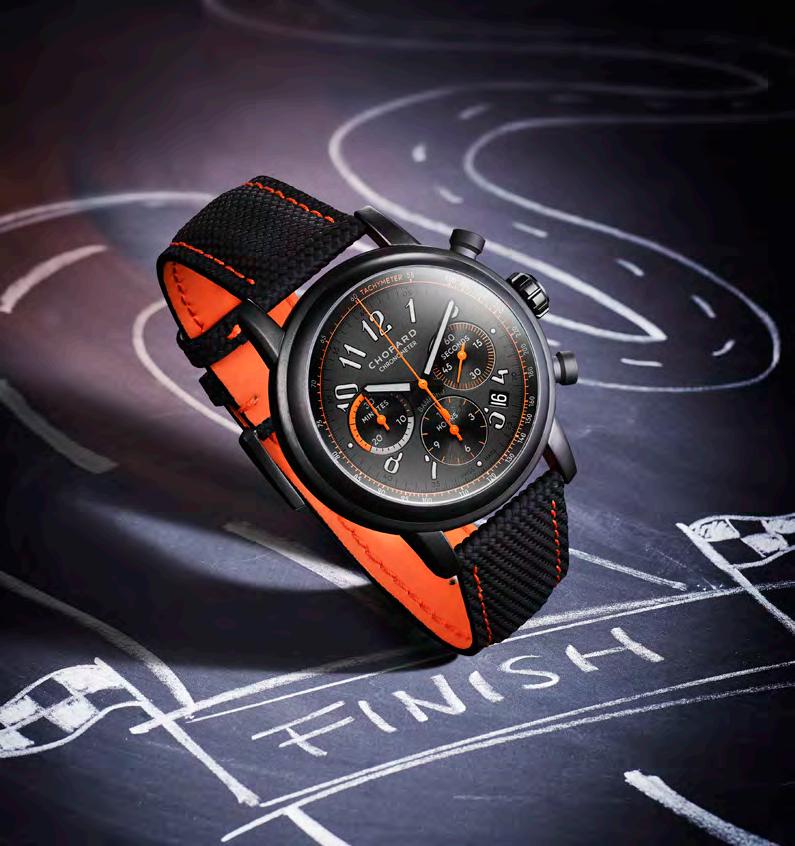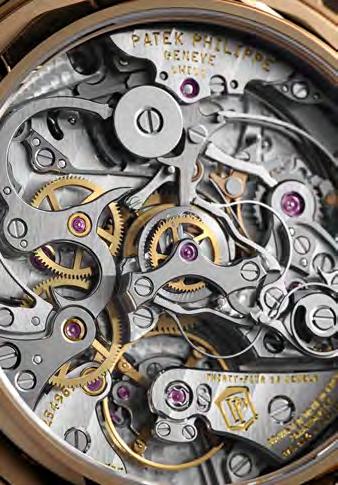
12 minute read
LONG LIVE THE KING
THE KING IS DEAD, LONG LIVE THE KING
NINE YEARS AFTER THE CURRENT MODEL WAS LAUNCHED, THE FIFTH GENERATION RANGE ROVER HAS LANDED. HERE, JAGUAR LAND ROVER’S CHIEF CREATIVE OFFICER, PROFESSOR GERRY MCGOVERN OBE, TALKS US THROUGH THE FINER POINTS OF THE NEW LUXURY OFF-ROADER
Advertisement
Words: Rory FH Smith
The vast majority of car launches slip by unnoticed by the general public. There are, however, a select few that bear global significance. The grand reveal of an all-new Range Rover is one such event. Now, 51 years after the original car first rolled off the production line, the latest iteration of the landmark off-roader has arrived. Before the car’s grand public reveal on 26 October, Luxury London was invited to the company’s headquarters in Gaydon, Warwickshire, for a behind-the-scenes preview. There, Jaguar Land Rover Chief Creative Officer, Professor Gerry McGovern OBE, walked us through the design and significance of what surely will be the new benchmark in off-road luxury.


“When the Range Rover was first introduced, it was regarded as the first luxury 4x4,” says McGovern in a cavernous, studio-lit design chamber. Beside him, it’s possible to make out a familiar silhouette, hidden under a dark-grey silk cover. “I think it was probably seen as a little bit of a novelty to begin with – a little bit quirky – something that appealed to a particular type of clientele. But over time, it’s created an indelible stamp on the psyche of the country, because it hasn’t changed too much – it’s evolved. It’s always been consistent with what it’s been about.”
When the original, boxy Range Rover first broke cover half-a-century ago, there was very little in the way of competition. There was the Jeep Wagoneer in the USA but, in reality, nothing compared to the go-anywhere ability of the Range Rover, which could be used on the farm during the day and then driven to the opera in the evening. Fifty-one years on, McGovern insists that the Range Rover’s reputation remains unchanged.
“It might seem like a contradiction, but the Range Rover has established itself as classless over time. This is a vehicle that you can drive to Monaco and park next to the most exotic vehicles in the world, yet it won’t feel or look inferior because it’s not trying too hard. Because of its distinctive silhouette and its values, I think the Range Rover has a level of respect with people who appreciate it for what it is.”
For the design chief and recently anointed Jaguar Land Rover board member, his involvement with Range Rover started in earnest with the third-generation model, which arrived in 2001 under the direction of BMW, the thenowners of the Land Rover brand.
“The third iteration was an interesting experience,” says McGovern. “I think it developed a real solidity at that point but the fourth one [2012] took it to another level. For me, though, this fifth edition is the best because of how it moves the game forward.”
The covers are pulled off, and there sit three shiny new Range Rovers under spotlights, slowly rotating on giant turntables. Sporting completely flush glazing and clean, expansive bodywork, void of all but essential lines, the aim, McGovern explains, was to create a “milled-from-solid” overall aesthetic. Looking at the front three-quarters, the car – while noticeably much cleaner – is not a vast departure
THE VITALS FOR THE NEW ENTRY-LEVEL 3.0L DIESEL RANGE ROVER
ENGINE 6 cylinder, 24 valve, direct injection
MAX POWER
183KW/249 PS
MAX TORQUE
600 NM
TRANSMISSION OVERALL LENGTH OVERALL HEIGHT WEIGHT 0-62MPH TOP SPEED
8-speed automatic 5,052 CM 1,870 CM 2,455 KG 8.3 SECONDS 135MPH
from the current model, with its side profile, grille and light configuration still very familiar. Edge towards the rear, however, and this model’s most significant and striking feature soon becomes clear. Tapering, boat tail-style, the rear of the car is defined by new, vertical taillights, which are encased in a single, gloss-black panel that wraps around the lower tailgate, defining the width of the car.
From all angles, it’s evident that McGovern and his team have gone to great lengths to hide or disguise any unnecessary lines – something the design boss calls “reductive design”. As a complete package, the Range Rover is an extraordinary exercise in clean and confident styling, with its vast, lineless surfaces defying convention and taking aim at rivals which suffer, as McGovern claims, with “an abundance of line work.”
It’s outside the studio that McGovern claims the Range Rover will have the biggest visual impact. “Seeing this car driving down the road, in Mount Street or Pall Mall, for example, is where it will really stand out because it’s so honed,” he says, gesturing to the point at which the bodywork seamlessly meets the flush glazing. “Put simply, it’s honed to within an inch of its life.”
On the inside, it’s a similar story. “I feel quite strongly that car interiors need to be calming in this world of 24/7 connectivity,” says McGovern. “If it’s going to be a luxury experience, it should be intuitive and it should put you at ease – you should be incredibly comfortable and calm inside it.”
Like the exterior, the interior is an exercise in minimalism. Sitting pride of place in the cockpit is a 13.1-inch curved, floating touchscreen housing Land Rover’s Pivi Pro infotainment system, from which all the main vehicle functions are controlled. Only the climate control can be adjusted by hard switches, which sit beneath the screen.
“It’s about creating a calm sanctuary through the rigour of our modernist approach to design,” says McGovern. Aside from the sanctity of the interior, the new long wheelbase Range Rover will come with the option of seven seats – something McGovern initially didn’t believe Range Rover owners would want. With room for seven adults on three rows of seats, the car is also available with a range of electrified powerplants ahead of the arrival of the first purely-electric model in 2024.
While few, if any, owners will use this ultrahigh-tech and sculptured generation of Range Rover as a farm-vehicle-cum-opera-taxi, it’s clear that McGovern and his team have aimed for evolution, rather than revolution.
“Our clients said, ‘don’t change it, just make it better’,” says McGovern. “When it comes to fashion and trends, we don’t do that. The design and the whole essence of the car is informed by this modernist design philosophy combined with the
evolution of Range Rover over the past 50 years.”
As the size, level of finish and technological capabilities of the Range Rover has developed, so too has its asking price. The current model starts at £83,500. Prices for the new iteration will shoot steadily up from £94,400. With a few extras, the new car is thrust into a space coinhabited by the Bentley Bentayga, Lamborghini Urus, Mercedes G-Wagon and Aston Martin DBX. It’s worth noting that all of those competitors, aside from the G-Wagon, sprung up within a three-year period following the launch of the current Range Rover – demonstrating just how fast the super-SUVs arms race hotted up.
What was once the undisputed – and unchallenged – King of the Off-Road now faces seriously capable competition. “There’s a lot of other brands out there, of course,” says McGovern. “But, quite frankly, they can do what they want because Range Rover is unique – there’s simply nothing else like it.”
From £94,400, landrover.co.uk


The pink-gold version of Audemars Piguet’s latest Royal Oak Offshore echoes the blue dial of the original 1993 release (p.84)
Collection

HIGH JEWELLERY AND HAUTE HOROLOGY
SECONDS OUT
THE HEADLINE STORIES AS HOROLOGY ENDS THE YEAR ON A FLOURISH
Words: Richard Brown
CHOPARD X BAMFORD
Barely a month goes by without pimp-my-watch guru George Bamford announcing yet another big-name collaboration. Following partnerships with TAG Heuer and Girard Perregaux, Chopard becomes the latest heavyweight horologist to team up with the undisputed champion of customisation. The base watch? Chopard’s Millie Miglia. Bamford’s contribution? Coating the chronograph in dark-grey diamond-like carbon (DLC), applying orange accents to its strap, tachymeter and sub-dials, and dialling up the cool factor to 10 in the process. £6,950, chopard.com


BREMONT
As Swiss giants monopolise the industry, people forget that Britain was considered the home of watch and clockmaking for 150 years. The new, limitededition Bremont Longitude goes a long way to rectify that fact. This will be the first timepiece to house the brand’s new ENG300 movement; built to Bremont’s unique specification, it is the first to be manufactured at scale in the UK for 50 years (at Bremont’s new manufacturing faciltiy, The Wing). A fantastic achievement for British horology. From £20,995, bremont.com


AUDEMARS PIGUET
Audemars Piguet continues with its evolution of the Royal Oak Offshore from 1993 with three new 42mm models. Presented in stainless steel, titanium or 18-carat pink gold, each incorporates a ‘Petite Tapisserie’ pattern, and both the stainless-steel and pink-gold variants feature the original blue dial. There are also some important differences: the new models are all equipped with AP’s latest integrated flyback chronograph, an interchangeable strap system, and slightly revised dial design. £74,100 for the pink-gold version, audemarspiguet.com

GIRARD PERREGAUX
Titanium has become the go-to material for the go-anywhere sports watch – unsurprising, given that the material is harder, lighter, more scratch-resistant and more corrosion-proof than steel. Titanium was discovered by an English clergyman in Cornwall in 1791, the same year in which a Swiss watchmaker was laying the foundations of what would become Girard-Perregaux over in Geneva. Cue the titanium-clad Girard-Perregaux Laureato Absolute Ti 230, on occasion of both the brand’s and the element’s 230th anniversary. £7,200, girard-perregaux.com

HUBLOT
Horologic hype brand Hublot has launched its second watch in support of the Kevin Pietersen-founded antirhinoceros-poaching charity SORAI, this time with a green ceramic case. £19,900, hublot.com
OMEGA
The new James Bond Seamaster has been executed in grade-2 titanium, making it lighter and harder to scratch. The stripped-down-to-thebasics tool watch has alos been slimmed to 13.55mm in height. £7,880, omegawatches.com
ROGER DUBUIS
Roger Dubuis’ latest titanium creation, the Excalibur Spider Pirelli, arrives with a quick-switch mechanism, allowing wearers to swap their straps, bezels and crowns at pit-stop speed. £52,000, rogerdubuis.com
VACHERON CONSTANTIN
In the five years since it was revisited, redesigned and re-released, Vacheron Constantin’s go-anywhere luxury sports watch, the Overseas, has been offered in an almost countless array of colours and case materials. So, what’s up for ’21? Two limited-edition ‘Everest’ pieces – a dual time (£26,600) and a chronograph (£31,400). Both feature steel bezels on titanium cases and are based on a prototype that scaled the summit of the world’s tallest mountain on the wrist of photographer-climber Cory Richards. vacheron-constantin.com
STOP THE CLOCKS
AFTER THE LAUNCH OF AQUANAUT AND NAUTILUS MODELS EARLIER IN THE YEAR, PATEK PHILIPPE RETURNS TO ITS ROOTS WITH THREE NEW HIGHLY-COMPLICATED CHRONOGRAPHS
Words: Timothy Barber
It would be a rum thing if, say, Henry Poole & Co became suddenly better known for an off-the-peg sports coat than for the bespoke tailoring that’s been its defining business for two centuries. But that’s the peculiar situation Patek Philippe finds itself in at the minute. The volcanic heat surrounding its stainless steel sports models, the Nautilus and Aquanaut – now going for four or five times RRP on the secondary market – has been somewhat drowning out the key fact that such watches are not really Patek Philippe’s business at all.
As if to remind us of the fact, the Geneva maker recently dropped a trio of watches that very definitely are. Classical, complicated and executed to an astounding level of luxury, they’re all chronographs, though each blends that central function with another high-end complication – a traditional Patek speciality.

REFERENCE 5204R-011
At the top of the tree is a new version of a watch that’s truly emblematic of Patek at the height of its powers: the Ref 5204 split-seconds chronograph and perpetual calendar. In Patek Philippe history, the combination of perpetual calendar and chronograph holds an especially reverential position; but including a far more complex split-seconds chronograph – with two chronograph seconds hands for recording split times – is another thing altogether. The new iteration is in rose gold with a suave slate-grey dial – though owners will be forgiven for spending more time staring in rapture into the knotted complexities of the movement. £238,620
All three chronographs blend that central function with another high-end complication – a traditional Patek speciality




REFERENCE 5930P-001
Next up is the Ref 5930P World Time flyback chronograph featuring a more esoteric combo of world timer (time in 24 time zones displayed at once) and flyback chronograph (meaning you can repeatedly restart the chronograph seconds hand as the small minute counter keeps running). The template is actually from a one-off watch dating to 1940, though the 5930 is a truly contemporary showstopper. Previously in white gold, we now get the platinum version, with the guilloche-engraved dial centre rendered in emerald green. Understated this is not; a very major flex to put any Nautilussporting whippersnapper in their place it certainly is. £77,420
REF 5905/1A-001
Patek Philippe does not follow trends, you understand. On the other hand, in the year in which green-dial watches are about as ubiquitous as disposable face masks, Patek releasing two at once (in addition to an Aquanaut and a couple of controversial Nautilus models earlier in the year) is a notable acknowledgement of the market. As is the fact that the second of these, Ref 5905/1A-001 Annual Calendar Chronograph – with a dial in sumptuous mossy green – is cased in stainless steel, and comes on a rather muscular bracelet. Packaging a high complication arrangement in a sportier exterior does show a brand moving with the times, and perhaps trying to draw some custom away from the absurd Nautilus/ Aquanaut market. After all, would you rather pay £100,000+ for a £27,000 Nautilus, or less than half that for a steel bracelet watch with far greater horological chops? Ah forget it – expect the waiting list for this one to be years long already, and the aftermarket price to headed north fast. £45,540, register your interest in all three watches at Wempe, 43-44 New Bond Street, W1S, wempe.com










